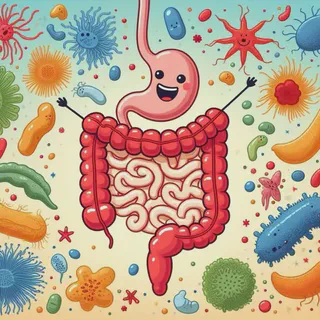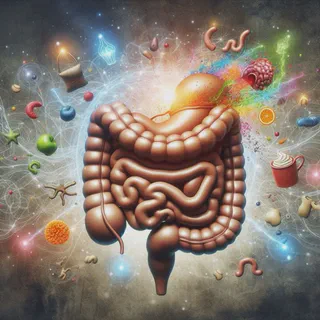Microbiome Evolution: How Gut Bacteria Shaped Human Development
Historical Context: The Ancient Partnership
The story of human development is incomplete without acknowledging our ancient microbial partners. For millions of years, gut bacteria have been active architects of human evolution, shaping everything from our immune systems to our brains. This symbiotic relationship predates human consciousness and continues to influence our health in profound ways.
The Dawn of Microbial Symbiosis
The partnership between humans and gut bacteria began approximately 2 billion years ago during the Proterozoic era, when single-celled organisms first established symbiotic relationships. These early microbial alliances laid the foundation for complex multicellular life, including the development of specialized digestive systems in early metazoans.
By the time the first hominids emerged around 7 million years ago, gut bacteria had already evolved sophisticated mechanisms for nutrient extraction, immune modulation, and metabolic regulation. The human gut microbiome represents a complex ecosystem containing over 100 trillion microorganisms, representing more than 1,000 different species.
Evolutionary Milestones
Paleolithic Era (2.5 million - 10,000 years ago)
During the Paleolithic period, hunter-gatherer populations maintained diverse microbiomes through varied diets rich in fiber, fermented foods, and seasonal plants. This dietary diversity fostered microbial communities that were highly adaptable and resilient.
Neolithic Revolution (10,000 years ago)
The transition to agriculture brought significant changes to gut microbial communities. While some beneficial adaptations occurred, the shift toward grain-based diets and reduced dietary diversity began to alter microbial compositions in ways that would have long-term health implications.
Industrial Revolution (18th-19th centuries)
The industrialization of food production introduced processed foods, refined sugars, and artificial preservatives that dramatically altered gut microbial ecosystems. This period marked the beginning of modern dysbiosis patterns that continue to challenge human health today.
The Co-Evolution of Immune Systems
Immune System Development
The human immune system evolved in constant dialogue with gut bacteria. This microbial exposure during early development was crucial for proper immune maturation. Studies show that germ-free animals develop immature immune systems with reduced T-cell diversity and impaired immune responses.
Key Evolutionary Mechanisms:
Toll-Like Receptor Evolution
Gut bacteria drove the evolution of pattern recognition receptors (PRRs) that allow the immune system to distinguish between harmful pathogens and beneficial microbes. This microbial "education" prevents inappropriate immune responses while maintaining vigilance against true threats.Regulatory T-Cell Development
Specific bacterial species, particularly those in the Clostridia family, promote the development of regulatory T-cells (Tregs) that maintain immune tolerance and prevent autoimmune diseases.Antibody Production
Gut bacteria stimulate the production of secretory IgA, the primary antibody found in mucosal tissues. This antibody coating helps maintain gut barrier integrity and prevents pathogen invasion.
Modern Immune Challenges
The "hygiene hypothesis" suggests that reduced microbial exposure in modern environments contributes to increased rates of allergies, asthma, and autoimmune diseases. This represents an evolutionary mismatch where our immune systems, adapted for constant microbial stimulation, now face sterile environments that fail to provide necessary immune education.
Metabolic and Nutritional Impacts
Microbial Metabolic Organ Functions
Gut bacteria function as a virtual metabolic organ, performing biochemical transformations that human cells cannot accomplish alone. This microbial metabolic capacity has been a driving force in human evolution.
Key Metabolic Contributions:
Short-Chain Fatty Acid Production
Bacteria ferment dietary fiber into short-chain fatty acids (SCFAs) like butyrate, propionate, and acetate. These compounds provide up to 10% of human energy needs and regulate gene expression, immune function, and appetite.Vitamin Synthesis
Gut bacteria synthesize essential vitamins including vitamin K, B vitamins (B12, folate, biotin), and vitamin B6. This microbial vitamin production was particularly crucial during periods of dietary scarcity.Bile Acid Metabolism
Bacteria modify primary bile acids into secondary bile acids that influence cholesterol metabolism, glucose homeostasis, and fat absorption.Amino Acid Metabolism
Microbial enzymes break down dietary proteins and synthesize essential amino acids, supporting muscle development and neurotransmitter production.
Evolutionary Dietary Adaptations
The human gut microbiome co-evolved with dietary patterns, developing specialized capabilities for processing different food types:
- Plant-based diets fostered bacteria capable of breaking down complex carbohydrates and fiber
- Animal protein consumption selected for bacteria that could handle protein degradation and fat metabolism
- Fermented food traditions encouraged beneficial lactic acid bacteria that provided natural preservation and health benefits
Gut-Brain Axis Evolution
Neurological Development
The gut-brain axis represents one of the most fascinating outcomes of human-microbe co-evolution. Gut bacteria influence brain development through multiple mechanisms:
Neurotransmitter Production:
- Bacteria produce serotonin (95% of body's serotonin)
- GABA synthesis for anxiety regulation
- Dopamine precursors for reward pathways
- Acetylcholine for cognitive function
Neural Development:
- Microbial signals influence neurogenesis in the hippocampus
- Gut bacteria affect blood-brain barrier development
- Microbial metabolites influence synaptic plasticity
Behavioral Evolution
Gut bacteria have shaped human behavior and social structures:
Food Preferences
Microbial signals influence taste preferences and food choices, encouraging consumption of microbe-friendly foods like fermented products and fiber-rich plants.Social Behavior
The gut-brain axis influences social bonding, empathy, and communication patterns. Studies show that social stressors alter gut microbial composition, suggesting evolutionary adaptations for group living.Risk Assessment
Microbial signals help regulate fear responses and risk-taking behaviors, crucial for survival in complex social environments.
Disease Resistance and Evolutionary Mismatches
Ancient Disease Resistance
Gut bacteria provided natural resistance against pathogens through:
Competitive Exclusion
Beneficial bacteria occupy ecological niches, preventing pathogen colonization through resource competition and direct antimicrobial production.Immune Priming
Constant microbial exposure kept immune systems in a state of readiness, preventing overreactions to harmless antigens.Barrier Enhancement
Microbial fermentation products strengthened gut barrier function, reducing systemic inflammation and pathogen translocation.
Modern Health Challenges
The modern lifestyle creates evolutionary mismatches that challenge our ancient microbial adaptations:
Antibiotic Overuse:
Widespread antibiotic use disrupts carefully balanced microbial ecosystems, leading to increased susceptibility to infections, autoimmune diseases, and metabolic disorders.
Processed Food Diets:
Modern diets lack the fiber and microbial nutrients that ancient microbiomes evolved to process, leading to microbial starvation and dysbiosis.
Hygiene Practices:
Excessive cleanliness reduces beneficial microbial exposure, impairing immune development and increasing allergic and autoimmune conditions.
Therapeutic Implications and Future Directions
Microbiome Restoration Strategies
Understanding our evolutionary microbial heritage suggests several therapeutic approaches:
Ancestral Diet Patterns
Reintroducing traditional food patterns that support beneficial microbial growth, including fermented foods, diverse plant fibers, and seasonal eating.Probiotic Interventions
Using evolutionarily relevant bacterial strains to restore microbial balance and function.Prebiotic Supplementation
Providing microbial nutrients that support the growth of beneficial species adapted to human physiology.Fecal Microbiota Transplantation
Transferring microbial communities from healthy donors to restore evolutionary microbial functions.
Research Directions
Future research should focus on:
- Longitudinal Studies
Tracking microbial changes across human lifespans to understand developmental patterns - Cultural Comparisons
Studying microbiomes in populations maintaining traditional lifestyles - Functional Genomics
Understanding how microbial genes contribute to human health and disease - Evolutionary Medicine
Applying evolutionary principles to modern disease prevention and treatment
Conclusion
The human gut microbiome represents a living record of our evolutionary partnership with microscopic organisms. These bacteria have shaped our immune systems, metabolism, neurology, and behavior in ways that continue to influence our health today. Understanding this ancient relationship provides powerful insights for addressing modern health challenges.
By recognizing the evolutionary context of our microbial partnerships, we can develop more effective strategies for maintaining health in an increasingly artificial world. The future of medicine may well lie in restoring the microbial balance that co-evolved with human physiology over millions of years.
Scientific References
Evolutionary History and Symbiosis
- Moeller, A. H., et al. (2016). "Cospeciation of gut microbiota with hominids." Science, 353(6297), 380-382.
- Sonnenburg, E. D., & Sonnenburg, J. L. (2019). "The ancestral and industrialized gut microbiota and implications for human health." Nature Reviews Microbiology, 17(6), 383-390.
Immune System Co-Evolution
- Belkaid, Y., & Hand, T. W. (2014). "Role of the microbiota in immunity and inflammation." Cell, 157(1), 121-141.
- Round, J. L., & Mazmanian, S. K. (2009). "The gut microbiota shapes intestinal immune responses during health and disease." Nature Reviews Immunology, 9(5), 313-323.
Metabolic Functions
- Koh, A., et al. (2016). "Microbial metabolites and immune regulation." Nature, 535(7610), 161-165.
- Tremaroli, V., & Bäckhed, F. (2012). "Functional interactions between the gut microbiota and host metabolism." Nature, 489(7415), 242-249.
Gut-Brain Axis
- Cryan, J. F., et al. (2019). "The microbiota-gut-brain axis." Physiological Reviews, 99(4), 1877-2013.
- Foster, J. A., & Neufeld, K. A. M. (2013). "Gut-brain axis: how the microbiome influences anxiety and depression." Trends in Neurosciences, 36(5), 305-312.
Disease and Modern Challenges
- Blaser, M. J. (2016). "Missing microbes: how the overuse of antibiotics is fueling our modern plagues." Henry Holt and Company.
- Rook, G. A. W., et al. (2013). "Evolution, medicine, and public health." Evolution, Medicine, and Public Health, 2013(1), 137-145.
Therapeutic Approaches
- Suez, J., et al. (2018). "Artificial sweeteners induce glucose intolerance by altering the gut microbiota." Nature, 514(7521), 181-186.
- Zmora, N., et al. (2018). "Personalized gut mucosal colonization resistance to empiric probiotics is associated with unique host and microbiome features." Cell, 174(6), 1388-1405.
Cultural and Evolutionary Studies
- Obregon-Tito, A. J., et al. (2015). "Subsistence strategies in traditional societies distinguish gut microbiomes." Nature Communications, 6, 6505.
- Schnorr, S. L., et al. (2014). "Gut microbiome of the Hadza hunter-gatherers." Nature Communications, 5, 3654.
Future Research Directions
- Gilbert, J. A., et al. (2018). "Current understanding of the human microbiome." Nature Medicine, 24(4), 392-400.
- Human Microbiome Project Consortium. (2012). "Structure, function and diversity of the healthy human microbiome." Nature, 486(7402), 207-214.
This article is part of our comprehensive gut health series. For more information on microbiome testing and optimization, explore our related articles on gut microbiome testing methods and comprehensive stool analysis.

